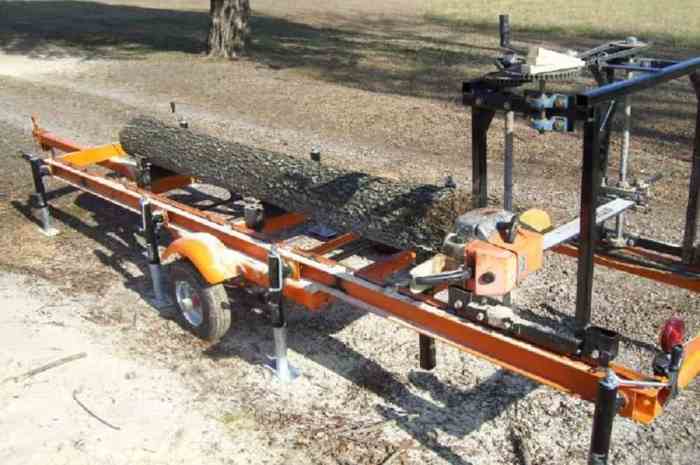DIY sawmill chainsaws are a fantastic way to turn logs into usable lumber, offering a unique blend of resourcefulness and woodworking skill. This guide will equip you with the knowledge and techniques needed to transform your chainsaw into a powerful milling tool.
From selecting the right chainsaw to setting up your mill, this guide will walk you through every step of the process. You’ll learn about safety precautions, milling techniques, and how to maintain your DIY sawmill for years to come. This is more than just a guide; it’s a gateway to a world of woodworking possibilities.
Introduction to DIY Sawmill Chainsaws

A DIY sawmill chainsaw is a versatile tool that allows you to transform logs into usable lumber. This can be a cost-effective and convenient option for individuals who need smaller quantities of wood for personal projects or home construction.
This guide will provide you with an introduction to DIY sawmill chainsaws, covering the benefits, types, safety precautions, and essential equipment involved.
Benefits of Using a Chainsaw for Milling Lumber, Diy sawmill chainsaw
Using a chainsaw for milling lumber offers several advantages:
- Cost-effectiveness: Chainsaw mills are generally less expensive than traditional sawmills, making them an attractive option for smaller-scale operations.
- Portability: Chainsaw mills are lightweight and portable, allowing you to mill lumber on-site, eliminating the need to transport logs to a fixed location.
- Versatility: Chainsaw mills can handle a wide range of log sizes and shapes, offering flexibility for various projects.
- Simplicity: Chainsaw mills are relatively simple to operate, making them accessible to individuals with basic woodworking skills.
Types of Chainsaw Mills
There are two primary types of chainsaw mills used for DIY projects:
- Portable Sawmill: These mills typically consist of a metal frame that attaches to the chainsaw, allowing you to cut lumber in a straight line. Portable sawmills are often used for smaller projects and are highly portable.
- Log-Splitting Chainsaw Mill: This type of mill involves using a chainsaw with a specialized attachment to split logs into boards. Log-splitting mills are suitable for producing rough-cut lumber and are often used for firewood or general construction purposes.
Safety Precautions and Essential Equipment
Chainsaw milling is a potentially dangerous activity. It is crucial to prioritize safety and use appropriate equipment:
- Safety Gear: Always wear safety gear, including chainsaw chaps, gloves, safety glasses, and hearing protection.
- Stable Work Area: Ensure a stable and level work area, free from obstructions. Secure the log using wedges or clamps.
- Sharp Chain: Maintain a sharp chainsaw chain for efficient cutting and reduced kickback risk.
- Emergency Plan: Develop a plan for dealing with emergencies, such as a chainsaw malfunction or an injury.
- First Aid Kit: Keep a well-stocked first aid kit readily available in case of accidents.
Setting Up Your Chainsaw Mill

After gathering your materials and tools, you’re ready to assemble your DIY chainsaw mill. This process requires careful planning and execution to ensure safety and efficiency.
Setting up a chainsaw mill involves assembling the various components, securing the mill to a stable platform, and ensuring that the chainsaw is properly mounted and adjusted. The setup process may vary depending on the specific design of your mill, but the general principles remain the same.
Types of Chainsaw Mill Designs
Different types of chainsaw mills offer unique advantages and drawbacks. Here are some common designs:
- Portable Mills: These mills are lightweight and easy to transport, making them ideal for small-scale operations or for use in remote locations. They typically consist of a frame with adjustable rails that support the log, and the chainsaw is mounted on a sliding carriage.
- Stationary Mills: These mills are heavier and more robust, providing greater stability and cutting accuracy. They are often designed for larger logs and for commercial operations.
- Combination Mills: These mills offer the versatility of both portable and stationary designs, allowing you to adjust the mill’s configuration based on your needs.
Securing the Mill to a Stable Platform
A stable platform is essential for accurate and safe cutting. Consider these factors when choosing a platform:
- Level Surface: The platform should be level to ensure that the log is supported evenly and that the cut is straight.
- Solid Foundation: The platform should be sturdy and able to withstand the weight of the log and the forces generated during cutting.
- Secure Mounting: The mill should be securely attached to the platform to prevent it from moving or shifting during operation.
“Use sturdy bolts and brackets to secure the mill to the platform, and consider using additional bracing to reinforce the structure.”
Building your own sawmill chainsaw is a rewarding journey that combines practicality with the satisfaction of crafting your own woodworking tools. By following this guide, you’ll be well-equipped to take on a variety of lumber-milling projects, from simple firewood to intricate furniture pieces. So, grab your chainsaw, embrace the challenge, and unleash your inner woodworker.
Building a DIY sawmill chainsaw can be a rewarding project, but it requires careful planning and safety precautions. If you’re looking for a more creative project, consider crafting a maleficent diy costume instead. The intricate details and dramatic design will certainly make a statement, and you’ll be able to enjoy the fruits of your labor without the risk of a chainsaw malfunction.
